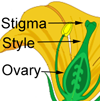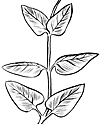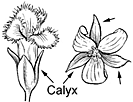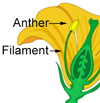Kanawao
Hydrangea arguta
Hydrangea/Mockorange family (Hydrangeaceae)
Native species ()
Kanawao is one of the most common shrubs in the understory of Hawaii’s rainforests, sometimes a small tree. This handsome plant is recognized by the large narrowly elliptical or leaves with finely edges and many long curved side veins, paired or three at a and by the large clusters of many small round bluish or dark red berries with narrow ring at tip.

©2011 Forest And Kim Starr
Leaves two or three at a ( or ), with stout fleshy leafstalk 3⁄4–2 inches (2–5 ) long, grooved above and enlarged at base. Blades large, narrowly elliptical or 4–10 inches (10-25 ) long and 1 1⁄2–3 1⁄2 inches (4–9 ) wide, long- or short-pointed at both ends, often widest beyond middle, slightly thick and leathery, with finely edges, upper surface shiny dark green and hairless with veins often sunken, lower surface light green with raised veins finely hairy.
Flower clusters () are and erect, broad, flattened or rounded, 2–4 1⁄2 inches (5–11 ) long and broad, with many short-stalked small flowers, male and female on different plants (). Male flowers about 1⁄2 inch (13 ) long and broad, composed of short with five pointed of five spreading petals almost 3⁄8 inch (10 ) long, white or tinged with blue or pink, 10 spreading nearly 1⁄2 inch (13 ) long, and small nonfunctioning Female flowers about 3⁄8 inch (10 ) long, composed of cup () bearing 5- 1⁄8 inch (3 ) long, five petals 1⁄16 inch (1.5 ) long, and with inferior five-celled short and five rounded stigmas.
() round, 3⁄8 inch (10 ) in diameter, bluish or dark red, fleshy. Seeds many, elliptical, minute.
Common and widespread in wet forests at low and middle altitudes of 1000–6000 ft (305–1829 ) through the Hawaiian Islands.
Special areas
Haleakala, Volcanoes.
Range
Hawaii only
Other common names
pu‘aha‘nui, kanawau, kupuwao, pi‘ohi‘a, akiahala, nawao
Botanical
Broussaisia arguta Gaud.
Broussiasia pellucida Gaud.
B. arguta var. pellucida (Gaud.) Fosberg.
This species is the only native Hawaiian example of its family, though several others have been introduced as ornamentals. Two varieties differing in leaf arrangement and flower color originally named as separate species have been distinguished.









